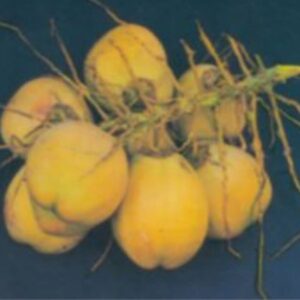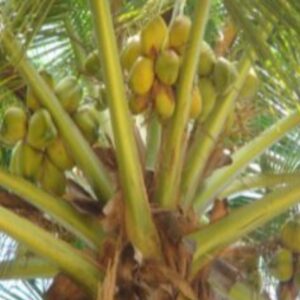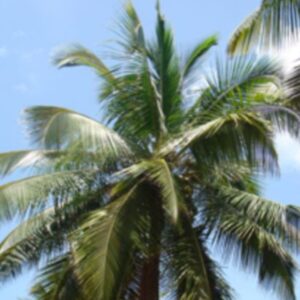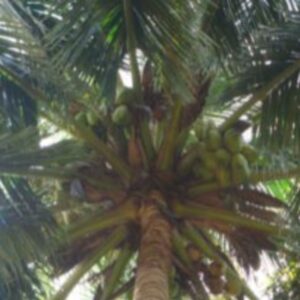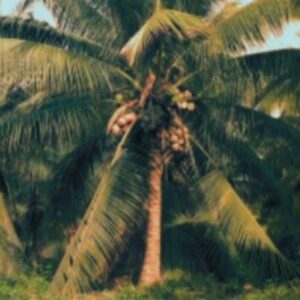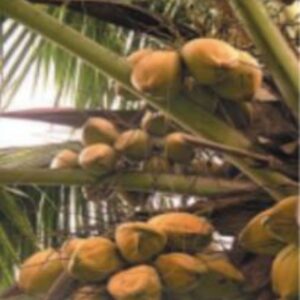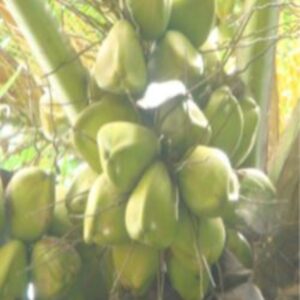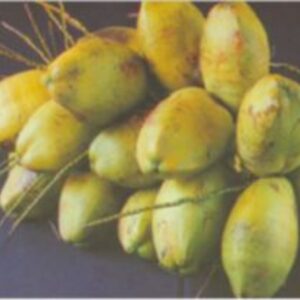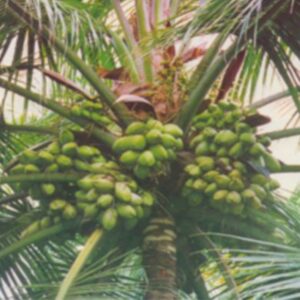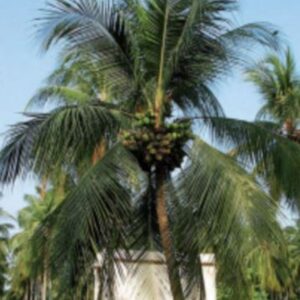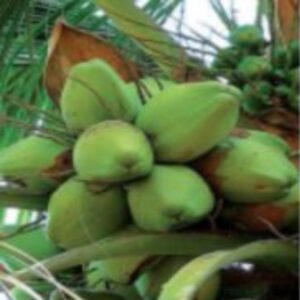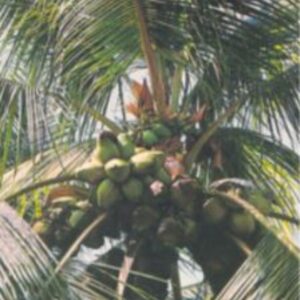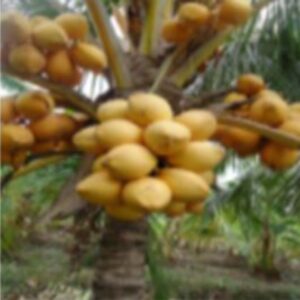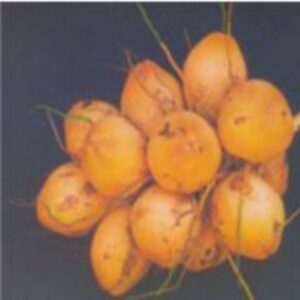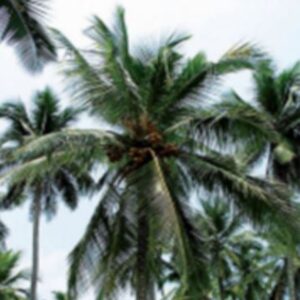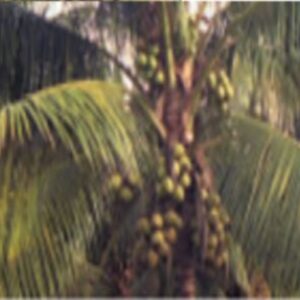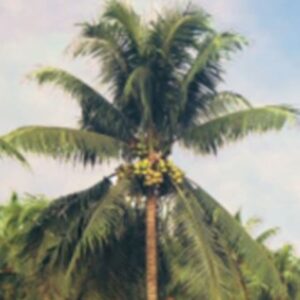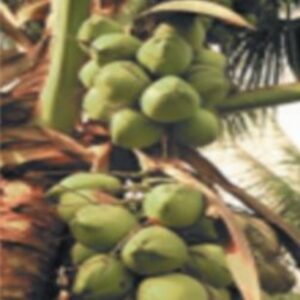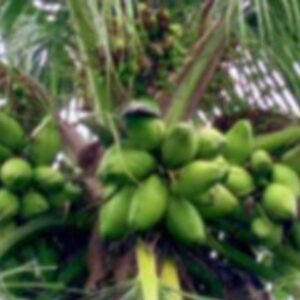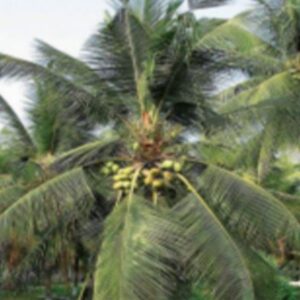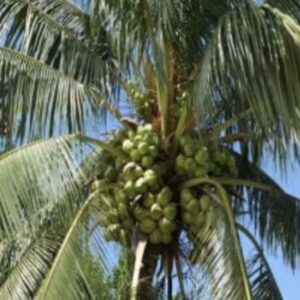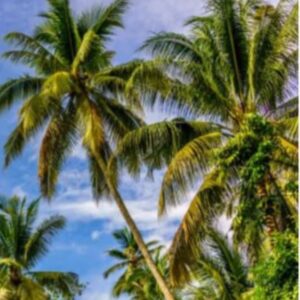Jay hind Farm
Coconut Varieties in India
Coconuts are mainly of two distinct varieties, the tall and the dwarf. It is predominantly the tall varieties that are cultivated in all coconut growing countries of the world. Productive life of tall varieties is about 60 to 80 years. They grow to a height of 15 to 18 m. The dwarf varieties are shorter in stature and their life span is short, compared to the tall varieties. Hybrids of the two varieties are also being developed. When selecting a variety of coconut seedling to be planted you must choose according to the suitability, need and lifespan.
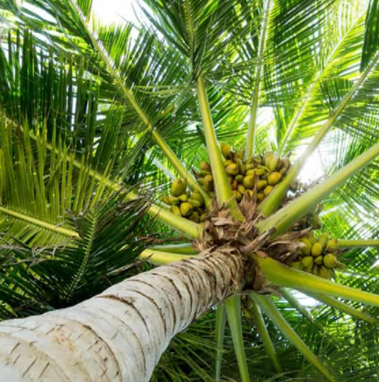
1. Tall Varieties
The tall varieties that are extensively grown in India are the West Coast Tall and East Coast Tall. Tiptur Tall (TPT), Lakshadweep ordinary (LCT), and Andaman Ordinary are the other types in this category. There are ecotypes of the major Varieties such as West Coast Tall and East Coast Tall. Kuttiadi, for example is an ecotype of the West Coast Tall (WCT).
1. West Cost Tall
Known as the Ordinary Tall variety, West Coast Tall has been extensively cultivated in India since ancient times and therefore could be considered indigenous to the country. The variety is popular along the west coast of India. In Kerala 95 per cent of the coconuts belong to this category.
The West Coast Tall grows to a height of 15-18 meters. The inflorescences have distinct male and female phases. The palm is not self-pollinated but is allogamous (cross pollinated). The palm starts yielding fruits in 6-8 years after planting. Coconut yield varies in different locations. The palm yields in the range of 74 to 90 nuts, with yields of 80 fruits per palm at Kasaragod. The nuts may weigh over 1 kg in mature palms, producing 160g copra per nut, with 68% oil content.The husk, being of good quality, is extensively used in making coir and coir products. The palm also yields coconut sap or toddy and the same can be made into jaggery or sugar.
WCT is tolerant to drought, but is sensitive to root wilt, bleeding disease, leaf blight disease and basal stem rot. The variety is recommended for planting in Kerala, Karnataka, Gujarat, Orissa, Maharashtra, Goa and Lakshadweep.
West Coast Tall is extensively used as the male or female parent for the production of Dwarf x Tall and Tall x Dwarf hybrids and the hybrids provide 20-35% more nut and copra yield than the parents. The successful hybrid varieties include Chandrasankara (COD x WCT), Kerasankara (WCT x COD), Keraganga (WCT x GBGD) and Kerasree (WCT x MYD).
West Cost Tall
2. Kuttiyadi
Kuttiyadi coconut is an ecotype of the West Coast Tall (WCT). West Coast Tall is the most popular coconut variety grown in Kerala and it occupies over 95 per cent of the area under coconut. The long history of coconut cultivation in Kerala has resulted in the development of many ecotypes of WCT. The Kuttiyadi ecotype grows predominantly in the hilly, midland region of Kozhikode District, at a place called Kuttiyadi. The marked difference in the genetic makeup and other characteristics of WCT and Kuttiyadi palms may have resulted from the locational differences in climatic conditions, pH level of the soil, annual rainfall and other environmental factors.
Its coconut is superior to other coconut varieties in terms of the number of coconuts it bears and the taste of its water, coconut flesh and oil. The average maturity time of Kuttiyadi coconut tree is 5 years. Many factors contribute to early fruiting such as water, sunlight, care, the distance of each tree planted, etc. The tree will grow up to 30-50 meters depending on the soil conditions.
If properly nurtured, it can yield over 150 nuts per annum. Kuttiyadi coconut is bigger and the fruit would come around 600 gm-800 gm without husk. The oil yield is 70 % and the smell of the oil is relatively more aromatic. An important attribute of Kuttiyadi variety is that it can give fruits for more than 100 years. Its trunk is so hard that it can be used for furniture.
Kuttiyadi
3. East Coast Tall
The East Coast Tall variety can grow to be a high tree, 90 feet tall at its maturity. This is one of the most widely cultivated tall varieties. The palm thrives in well drained deep sandy loam, alluvial and red loamy soils. It normally takes 6 – 8 years to starts bearing fruit and the average annual yield is around 70 coconuts.
It provides usually medium-sized green coconuts, and are rich in coconut oil and its fleshy content may contain nearly 65% oil. The nuts are smaller than West Coast Tall and the copra content is 125 gram / nut and it the ranges between 100 and 140 gram.
They thrive best in loamy soils and any other form of well-drained soil. The East Coast Tall coconut tree is moderately tolerant to lethal pests like bugs, mites, and insects. The variety has been recommended for large scale cultivation in coastal areas of Tamil Nadu, Andhra Pradesh, Bihar, Pondicherry, Orissa, Madhya Pradesh, Andamans and West Bengal.
East Coast Tall
4. Tiptur Tall
This cultivar (variety) is popular in Karnataka. Tiptur is believed to have got its name from the Kannada word “tipatala”, which means “copra.” Tiptur Tall is a tall palm that grows well even in the inland areas, located away from the sea coast and in areas with a low average annual rainfall of about 50-64cm. The palm grows to a height of approximately 8.8-10.8 meters. TPT is similar to West Coast Tall (WCT) in most morphological characters. The trunk is not very thick (71-87 cm girth).
The palm begins to flower in 6-7 years after planting. Cross-pollination is the rule, but some self-pollination is possible due to overlapping of male and female phases. The coconuts are large, oval, and brown.. It is a regular bearer, producing about 9-11 bunches per year. The yield varies from 73-99 nuts per annum, with an average of 85 under rain-fed conditions. The fruit is big, with a nut weight of 586g. The average copra content is 187g per nut and the oil content is 68.4%.
This is one of the best varieties of Karnataka. The variety can withstand longer periods of drought and tolerates diverse soil and climatic conditions.The palm provides good yield even under rain-fed conditions and can therefore be used for commercial planting. The fruit is suitable for consumption as tender nut.
Tiptur Tall
5. Andaman Ordinary Tall
Extensively grown in the Andaman and Nicobar Islands, this cultivar was introduced to the Indian mainland in 1941. Andaman Ordinary Talls are more vigorous than other local Talls. The height of the palm is about 10 m. The palm is predominantly allogamous (cross pollination). It takes 5 to 6 years for bearing fruits.
The average yield is 92 nuts per palm per annum and the yield ranges from 40 to 133 nuts. The fruit is oval and is yellow, green or brown in colour. The nut inside has a thick kernel and a thin shell. The copra content is 176 gram per nut and the oil content is 70 per cent.
It is drought tolerant and is suitable for rain fed and irrigated condition. It is moderately tolerant to root (wilt) disease and resistant to stem bleeding disease. The palm was used as parent for the production of Dwarf x Tall and Tall x Dwarf hybrids. It has been used as a female parent in the production of Anandaganga (ADOT x GBGD) hybrid.
Andaman Ordinary is common in Andaman and Nicobar Islands because of its high yield. The palm is also a good yielder of toddy. Farmers plant this variety in large numbers in several states, especially in Karnataka. This variety was released by Coconut Research Station, Veppankulam, Tamil Nadu, during 1994 for commercial cultivation in the states of Tamil Nadu, Kerala, Andamans, Andhra Pradesh, Bihar, Assam, Orissa, Madhya Pradesh, Pondicherry, Tripura and West Bengal.
Andaman Ordinary Tall
6. Laccadive Ordinary Tall (LCT)
LCT was introduced to the Indian mainland in 1940. The palm grows in all types of soil and it can withstand moisture stress.
The palm grows to about 11.6 m with a stem girth of 80 cm. It starts flowering in about six years after planting. The fruit is medium-sized and the colour varies from greenish yellow to brown. The nut is oval and has thick kernel and shell.
The palm starts fruiting about six years. The average yield is 100 nuts per palm per annum. The copra content is 176 gram per nuts and the oil content is 72 per cent. The palm is good for tapping sweet toddy and the yield of toddy is nearly twice the one obtained from West Coast Tall.
The palm is popular among the farmers due to its stress tolerance. It is tolerant to drought but susceptible to root (wilt) disease. It is used for the production of hybrids such as ‘Chandralaksha’ (LCT x COD) which gave yields higher than either of the parents.
This variety was released by CPCRI, Kasaragod during 1985 under the name ‘Chandrakalpa’ for large scale cultivation in the state of Kerala, Tamil Nadu, Karnataka, Andhra Pradesh and Maharashtra.
Laccadive Ordinary Tall (LCT)
Why Choose Tall Varieties of coconut ?
- They grow up to an altitude of 3,000 ft. above the sea level.
- The tree attains a height of about 15m to 18m or even moreTheir life span is long and they reach an age of about 80 to 90 years.
- They thrive under different soil conditions, varying from littoral sands to red loams and laterites.
- They are fairly resistant to diseases and pests.
- They start yielding nuts in about 5 to 8 years after planting
- The nuts are medium to big in size and vary in shape from spheroid to linear-oblong, with colours from green, yellow and orange to shades of brown.
- They produce copra of good quantity and quality with fairly high oil content
2. Dwarf Varieties
1. Chowghat Green Dwarf (CGD) / Pathinettampatta
CGD was first identified in the Chavakkad area of Trichur District of Kerala. It is locally known as ‘Pathinettampatta’, because the inflorescence generally emerges from the 18th leaf axil. In many respects CGD is similar to the Sri Lanka Green Dwarf (Pumilla Green Dwarf).
CGD grows to a height of about 4.5 meters. The variety is self-pollinating and it starts flowering in 3-4 years. The yield and production varies in different places and the palm produces 30 to 100 nuts per year. The nuts are green and the shell and kernel are thin. The fruits are small, weighing about 450g. The husked nut is about 190g. The copra content is low, ranging from 38 to 100g and the oil content is 66%.
The palm is sensitive to drought. It has high tolerance (over 90%) to root (wilt) disease. CGD is highly resistant to lethal yellowing and is tolerant to the rhinoceros beetle. Tolerance to root (wilt) and lethal yellowing diseases makes CGD a preferred variety for the production of disease tolerant hybrids.
Chowghat Green Dwarf (CGD) / Pathinettampatta
2. Chowghat Orange Dwarf (COD)
Chowghat Orange Dwarf was first identified in the Chavakkad area of Trichur District of Kerala. COD is known as ‘Chenthengu’or ‘Gowrigathram’ and households in Kerala plant one of two palms of this variety as ornamental plant and for sweet tender nut water. The fruits are usually orange in colour and sometimes yellow.
The palm is a Dwarf variety and grows up to 5 meters. It flowers in 3.5 to 4 years. COD is not strictly self-pollinating, as cross pollination also takes place. The fruit is round/oval with a thin husk, thin shell and thick kernel. The 7-month old tender nut water is sweet. COD yields about 60-65 nuts per annum. The copra content ranges from 112 to 195g with 66% oil content.
Sensitive to drought and water logging, it is also vulnerable to leaf spot (gray blight) and stem bleeding disease, but less susceptible to root wilt disease. COD is extensively used as female parent in Dwarf x Tall hybrids and serves as pollen parents in Tall x Dwarf seed production.The high-yielding hybrid COD x WCT (Chandrasankara), its reciprocal hybrid (Kerasangkara) and LCT x COD (Chandralaksha) have been produced and distributed extensively by CPCRI. it is now cultivated in large areas for tender coconut production.
Chowghat Orange Dwarf (COD)
3. Malayan Green Dwarf (MGD)
Globally the green form of the Malayan Dwarfs is less widespread compared to the yellow and red forms. MGD, used mainly as an ornamental palm, is often planted in gardens. The palm doesn’t grow as tall as the other Malayan varieties and it grows to a height of 10 meters. MGD has generally a thin stem, about 20 to 25 cm in diameter. Like the other Malayan varieties MGD is fairly easy to grow.
Under good farm conditions, MGD starts flowering in 2-3 years after planting. This variety produces green coconuts and the coconuts typically contain more water and less meat.The nuts are bigger, rounder and with a higher kernel content. It may produce 30-80 fruits per palm per year (without irrigation). The average fruit weight ranges from 724g (in India) to 890g (in Malaysia). On an average, the nuts weigh from 396g to 641g. Water from young nuts is tasty. The palm is sensitive to drought and is highly prone to alternate bearing.
Malayan Green Dwarf (MGD)
4. Malayan Yellow Dwarf (MYD)
The Malayan Yellow Dwarf is probably the most widely diffused Dwarf coconuts in the world. Experts note that the Dwarf palms were introduced into Malaysia between 1890 and 1900 by planters from Indonesia. MYD is the most utilized variety worldwide in coconut breeding.
Pale yellow is the colour of the MYD seedling sprouts, the leaf stalks, the inflorescence and the immature fruits. When the fruits are young (6 to 9 months), their colour is often a pale yellow-green. Many other Yellow Dwarfs (YD) look similar to the MYD, such as the Sri Lanka YD, Nias YD in Indonesia, Chowgat YD in India, and others.
MYD grows to a height of 10-20 meters (30-60 feet). It flourishes in full sun and well-drained soil. Under good field conditions, the Malayan Yellow Dwarf starts flowering in 3 years after planting and it may produce 80-100 fruits per year per palm without irrigation.
The palm generally produces medium-sized, oblong fruits, weighting 700 to 800g. But the fruit weight varies from 370g (in India) to 1752g (in Vanuatu), depending on environmental factors. The nuts are almost spherical and generally weigh 350-450g each. Water from young nuts is sweet. The kernel is thin and the copra has an oil content of about 69%. MYD is sensitive to dry and unfavourable environmental conditions. It is subject to alternate bearing.
Malayan Yellow Dwarf (MYD)
5. Gangabondam Green Dwarf (GBGD)
Cultivated extensively in east Godhavari district of Andhra Pradesh, GBGD is mainly used for tender nuts. The palm height ranges from 405 to 538 cm and it has a thin stem.
The palms start flowering in 4-5 years after planting. The variety is predominantly self-pollinating and breeds 95% true-to-type. Cultivated extensively in all the south Indian states today, Gangabondam yield and production varies in different locations and the yield is in the range of 46 to 112 nuts. The average yield is in the range of 60-70 nuts per annum. The nuts are heavy (804g) with high nut weight (511g). The kernel is thick and gives 184g of copra per nut, with oil content of 64% at Kasaragod.
Gangabondam Green Dwarf is sensitive to drought and is susceptible to root wilt disease; less susceptible to stem bleeding disease. GBGD is widely used as female and male parent for the production of hybrids such as Lakshaganga (LCT x GBGD), Keraganga (WCT x GBGD) and Anandaganga (ADOT x GBGD) and the hybrids provide higher nuts and copra yield. The hybrid WCT x GBGD was found to be tolerant to rhinoceros beetle attack.
Gangabondam Green Dwarf (GBGD)
6. Deejay
Deejay is a hybrid variety involving WCT and COD developed several decades back. There are several farms in Tamil Nadu with this variety. It is a semi tall variety. The coconuts are good for tender coconuts as well as copra.
The variety flowers in 3 years after planting and yields almost three times the number of nuts per year compared to ordinary tall varieties. The annual yield could be around 200 nuts. The palm yields big nuts and the oil content is high.
Deejay
Why Choose Dwarf Varieties of Coconut ?
Dwarf varieties are shorter in both stature and life span.
- They grow to a height of 5-7 meters.
- The average life span is 40-50 years.
- They bear fruits in 3-4 years.
- The dwarf varieties are generally grown for tender coconuts.
- They are also used for hybrid seed production.
- Dwarf palms are predominantly self-pollinated.
- The nuts are smaller and the copra is thin, leathery and low in oil content.
- Dwarf varieties produce green, orange and yellow nuts.
Hybrid Varieties
Why Choose Hybrid Varieties of Coconut ?
- Hybrids are the inter-varietal crosses of two morphological forms of coconut.
- They flower early, normally in 3 years.
- They provide higher nut yield as well as higher quantity and better quality of copra when compared to the parents.
- When the tall is used as female and dwarf as male, they are all called T x D hybrids, while the reciprocals are known as D x T hybrids.
- Hybrids perform well under good management conditions including nutrient, irrigation and crop protection.
Jay hind Farm is proudly powered by WordPress

